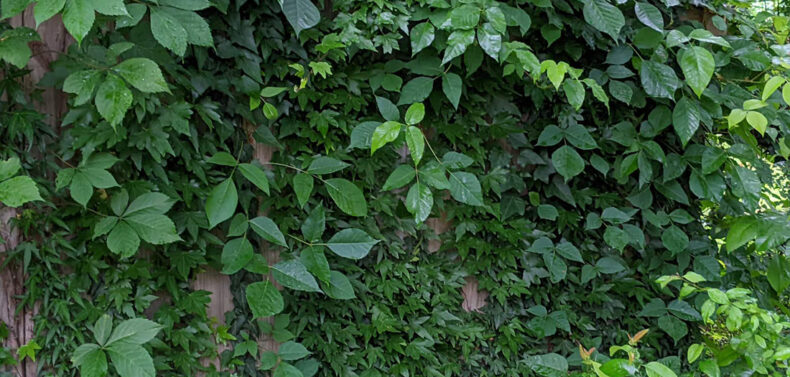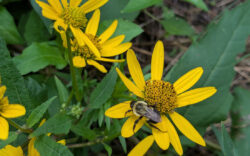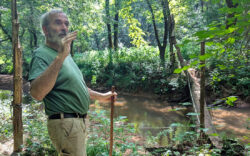Native or not, Georgia’s climate and soil grows some gnarly vines. Whether you’re planting, clearing brush or hiking a trail, here’s how to identify some of the most common climbers you’ll meet this summer.
Poison Ivy: It’s worth a quick refresher every spring to make sure you can identify poison ivy. Leaf edges can be serrated or smooth, but always come in groups of three. Another giveaway: The stems look hairy. New growth can be red before maturing into a bright or dark green. Poison ivy survives all types of soil conditions, and generally prefers areas with some mix of sunlight and shade. This toxic plant is native to Georgia and grows white berries popular with native wildlife. Reactions to poison ivy vary greatly, but it’s better to be careful than sorry. My Cajun grandfather could pull poison ivy with his bare hands—and did until he got careless and wound up sitting on a few stray leaves ground into the seat of his pick-up truck. The man who bragged for years about his hardiness over poison ivy wound up with a butt full of angry red rashes.
I pull up poison ivy in the spring, after a heavy rain, with long sleeves and disposable gloves. I either feed it to the goats or throw it in the trash. Don’t burn this vine. Fire causes the burning, itching chemicals to float through the air and can cause serious lung and eye issues. Briefly brushing up against poison ivy generally doesn’t cause a rash. If you find a hole in your glove, or otherwise suddenly find yourself exposed to the plant’s sap, wash it off with soap ASAP. I’ve had luck with the cleanser Tecnu, especially after handling goats who’ve munched on a poison ivy buffet all day.
English Ivy: This non-native plant looks so pretty in photos and easily disguises the pain it is to have in your garden. It’s not worth it. English ivy leaves are glossy, lobbed and generally have lighter coloring along the veins. Like poison ivy, the vine’s main stem looks hairy. This plant is an evergreen that can grow up the tallest pine trees and pull them down. English ivy hides nasties like poison ivy and bacterial leaf scorch—a disease that can injure and kill oaks, maples and blueberries without doing much damage to the host. English ivy can also trap moisture and provide a damp environment for mosquitoes to breed legions of fellow bloodsuckers. It will take several years of concentrated removal to get this vine gone. I run it over with the lawnmower throughout the summer and have managed to contain it to three small-ish areas.
Virginia Creeper: A native poison ivy look-alike, it’s not as bad as many folks think. The Virginia creeper can be a pain, but it’s more manageable than some of the others on this list. New growth on these vines also start out red, like poison ivy, but the stems look hairless. Sometimes, new growth will sprout three leaves, but older, more mature parts of the plant display five-fingered leaves. I’ve heard several folks identify Virginia creeper as poison oak, and though that’s not true (poison oak sprouts leaves in bunches of three as well), some people can develop a rash after touching Virginia creeper. The vine contains raphides, needle-shaped crystals made of different types of calcium common in plants such as kiwi, pineapple, rhubarb and elephant ears. If you’re new to gardening and unsure whether you’ll develop a rash, wear gloves and go slow.
My best argument for letting some Virginia creeper grow unencumbered in your yard is that the Japanese beetles love it. While the beetles feast on Virginia creeper, you’ll get to keep more precious plants safe from the scavengers. I control most of my yard’s creeper by chopping the plant back to the roots in the winter so it just grows the same span year after year.
A General Warning: Vines, whether native or not, can grow gangbusters here. If you’re looking to replace Japanese honeysuckle with the native trumpet honeysuckle, check on the scientific name. While the native trumpet honeysuckle (Lonicera sempervirens) can grow up to 20 feet in one season, the native trumpet creeper or trumpet vine (Campsis radicans) can manage a whopping 35 feet. The vine is so aggressive outside of gardens some folks know it by the common name “the hell vine.”
Like what you just read? Support Flagpole by making a donation today. Every dollar you give helps fund our ongoing mission to provide Athens with quality, independent journalism.










